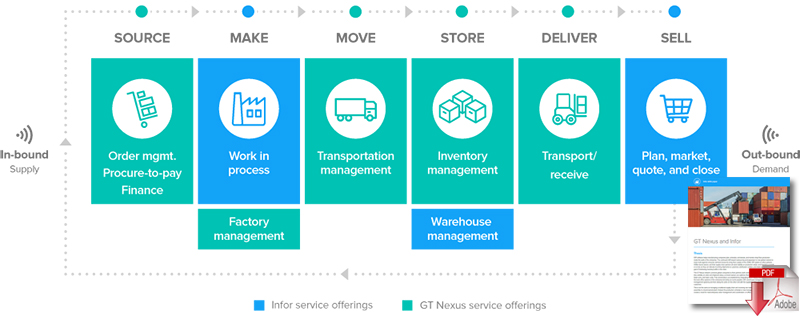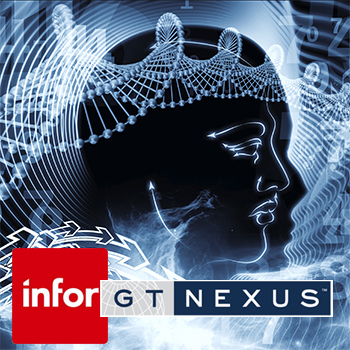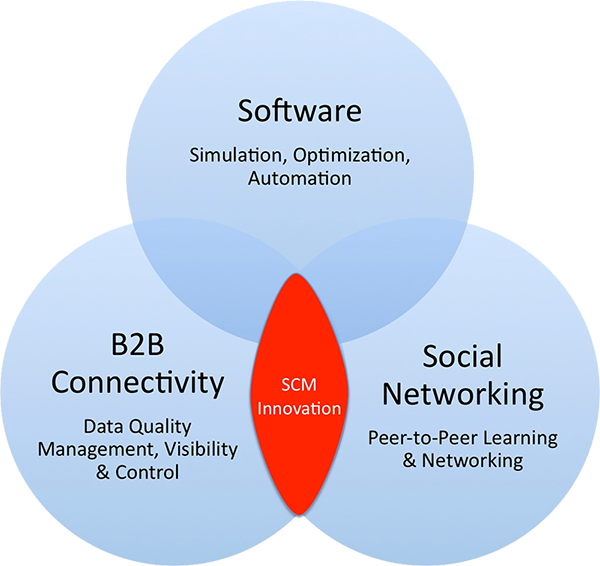Company officials said the Infor GT Nexus acquisition purchase price was $675 million.
GT Nexus provides cloud-based solutions for manufacturers, retailers, and logistics service providers, with roughly 25,000 business leveraging its services, including six of the top ten logistics service providers and 30 financial institutions that each manage more than $100 billion in goods per year through GT’s cloud-based business network.
The company’s technology is comprised of a global order management system, which coordinates commerce across partners, and it enables retail, manufacturing, and fashion shippers to collaborate with suppliers so they can manage and optimize shipments to customers, distribution centers, and retail outlets to meet demand.
Infor said that this acquisition allows the company to create the first global commerce cloud with end-to-end control and visibility fort the production of the products that companies make and deliver to their respective markets.
“Together, Infor and GT Nexus will provide customers with unprecedented visibility into their supply chains to manage production and monitor goods in transit and at rest,” said Charles Phillips, CEO of Infor, in a statement issued in August.
“In a complex, high velocity supply chain, all partners need to know what was ordered, when it was built, where it is in transit, if the order has changed, and has it cleared customs. Specialization and speed are moving the future of manufacturing into the commerce cloud.”
Phillips’ previous position as a managing director at Morgan Stanley was cited by John Flavin, Infor EVP of Manufacturing and Distribution Solutions as serving as a driver for this deal.
Setting the stage for what’s next: end-to-end commerce in the cloud

“In April 2000…Phillips co-authored a report with Mary Meeker called The B2B Internet Report: Collaborative Commerce, which shows how advanced Charles’s thinking and vision was for a world of connected, collaborative commerce enabled by cloud computing,” he said.
In the report, Phillips and Meeker wrote, “we expect that market efficiency resulting from business-to-business (B2B) ecommerce will provide buyers and sellers with unprecedented levels of market transparency via online exchanges.”
And with the agreement to acquire GT Nexus, Flavin said Phillips has taken a major step toward delivering on his own vision. ERP Software has served for decades to manage processes within a company’s four walls, but cloud computing has paved the way for connected networks, like GT Nexus, to bring all parts of the supply chain together, he said, adding that integration of ERP with this network closes the loop, producing an end-to-end global commerce cloud to drive unprecedented levels of transparency, collaboration, and efficiency.
When asked what specific needs this acquisition fills for Infor, Flavin said that GT Nexus, like Infor, is built on open-standards to facilitate integration with various enterprise systems, and Because of this, he said Infor expects integration between Infor CloudSuite and GT Nexus to be complete very quickly, with GT Nexus providing the connectivity platform to extend Infor CloudSuite beyond the four walls of the enterprise across the entire supply chain, delivering an end-to-end global commerce cloud.

Flavin said that the next steps in regards to actual integration will be akin to what Infor has done with previous acquisitions like Lawson, PeopleAnswers (Infor Talent Science), and Saleslogix (Infor CRM) in that it will pour resources into delivering the integration necessary to drive value for customers.
Because both Infor CloudSuite and GT Nexus are built using open standards, this integration will be much simpler, which is one of the primary reasons Infor ION, our integration engine was designed this way – it is engineered for speed,” he said.
Steve Banker, an analyst at ARC Advisory Group, said this deal makes sense for Infor, as GT Nexus has a good product in terms of tracking shipping moves at a granular level across the ocean.
“For long outsourced supply chains that start in Asia and end in N. America or Europe, it is particularly useful when things like [for example] should a Port of Long Beach strike occur,” he said. “The solution gives you the ability to quickly look at alternatives, one week the port of Tacoma might be the right entry point, the next week another port.
Banker added that some big companies are starting to build large supply chain control towers to better deal with supply chain risk management, and he explained that a solution like GT Nexus built upon a many-to-many, public cloud architecture with common network master data is the best platform for end to end supply chain visibility.
What’s more, he said, this is moving in the same direction as SAP when they announced a Supply Chain Control Tower solution that would leverage the Ariba Network to build out the visibility portion of the SAP solution. But whereas SAP intends to be a one stop shop for visibility and Supply Chain Planning/Execution, Banker said GT Nexus will run as an independent division and will often be bundled with solutions from other vendors – a coopetition strategy.
Adrian Gonzalez, founder and president of Adelante SCM
Of all the ERP CEOs today, Charles Phillips understands the value and potential of online B2B networks the most. He and Mary Meeker wrote the paper on it more than 15 years ago, and although getting to “communities of commerce” took a different path than they had envisioned, we are there nonetheless in the form of Supply Chain Operating Networks.
From a software application standpoint, there is also good synergy between Infor and GT Nexus. For example, although Infor has acquired various transportation management system applications over the years (CAPS Logistics, Arzoon, ShipLogix), GT Nexus offers a more modern, network-based solution for clients, and as I discussed earlier this week in my takeaways from the GT Nexus Bridges 2015 conference, GT Nexus is making significant investments in expanding and enhancing its TMS capabilities and footprint.
Another great opportunity is for GT Nexus to leverage Infor’s Ming.le technology to enhance its user interface and introduce social networking capabilities, which I view as the next frontier for Supply Chain Operating Networks (see Where to Find Supply Chain Innovation).
The biggest risk, in my opinion, is for Infor to try to make GT Nexus into something that it is not. Just like a square is a rectangle but a rectangle is not a square, a network-based solution is a cloud solution but a cloud solution is not necessarily a network-based one, especially if cloud is equated with “hosted.” The press release states that “the addition of Infor CloudSuite technology to the GT Nexus network will enable businesses to go further by integrating merchandising, marketing, and demand data instead of extrapolated forecasts for improved sales, operations, and production planning.” How Infor ultimately defines and executes the integration of its CloudSuite technology and the GT Nexus network is where I see the biggest risk.
On the plus side, keeping GT Nexus as an independent business unit is a good move. Ideally, moving forward, the Infor and GT Nexus teams will be equal partners in defining their future direction and strategy, versus having the Infor team alone calling the shots.
Source: This Week in Logistics News
Related: Infor Aquires GT Nexus - If I Had a Magic Wand!

About the Author
Follow Robotics 24/7 on Linkedin
Article topics
Email Sign Up


















